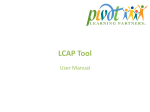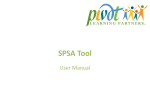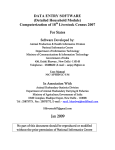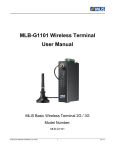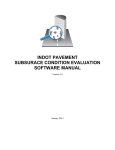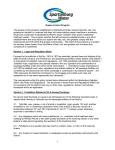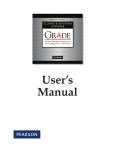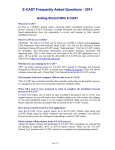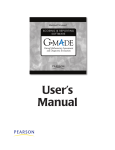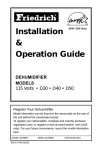Download SPSA Tool User Manual
Transcript
SPSA Tool User Manual Contents • • • • • • • • • • • • • About the SPSA Tool……….……………………………………………………………………………...4-7 Login…………………………………………………………………………………………..……….……..……..8 Home Page…………………………………….…………………………………………..…….………..………9 School Basics………………………………………..………………………………..…………………..10-13 Committees…………………………………………….……………………………….………………...14-16 School Resources………………………………………………….…………….………………………17-18 Needs Assessment…………………………………………………………………………..………….19-20 Plan…………………………………………………………………………………..…..……………………21-22 Copy Goals and Strategies………………………………………………….………..…………….……23 Goals…………………………………………………………………………..………..…………………………24 Strategies……………………………………………………….……………………….……..…………….…25 Actions…………………………………………………………………….………………………..…………...26 Expenditures……………………………………………………………………..…………………..……27-28 2 Contents • • • • • • • • • • • • • • Priorities…………………………………………………….………………………..…………………………29 Budget………………………………………..…………..………………………..…………………………..30 Edit Fiscal Year Allocations ……………………………………….………………………………………..31-32 Reports………………………………………………….……………………………..……………………33-35 Change Password…………………………………………………………………………………………….…36 Help, Logout, and Switch Site Plans ………………………………………….…………..……………37 Settings – Add Schools (Admin Only) …………….…………………………..……..…………38-39 Settings – Create Sub-Districts (Admin Only) ….…………………………...…..…………40-41 Settings – Add Users (Admin Only) ………………………………………………………….……42-43 Settings – Needs Assessment Questions (Admin Only) …………………………………44-45 Settings – Change District Values (Admin Only) ………………….……………..……..……46-47 Settings – Create Site Plan (Admin Only) ………………….………………………………………….48 Settings – Prepare Annual Rollover (Admin Only) ……………………………….…………49-50 Other Features …………………………………………………………………….………………………………51 3 SPSA Tool Pivot’s LCAP & SPSA Tool (the Tool) was designed to support districts to complete their SPSA through a step by step process that helps schools examine, evaluate and increase the efficiency and effectiveness of school planning and budgeting, as well as the equity of resource allocation from the district to school sites. 4 The Tool Aligns the Planning and Budgeting Process Implement Begin implementation of school site plan: • Training and PD calendar for staff • Community Asset Mapping Review and Revise Summer Needs Assessment: • Student achievement* • Community engagement* Review Current Plan: • Set goals* • Develop strategies* Fall Ongoing stakeholder engagement and data analysis Finalize • • • Layoff notices Review budget and school site plan with stakeholders Submit school plan for final School Board approval* Spring Winter *Activities supported by the Tool Budget (for next school year): • • • • • Identify resources* Prioritize expenditures* Draft a budget* Gain consensus with stakeholders Finalize staffing decisions “He who fails to plan is planning to fail.” Winston Churchill 5 About the Tool Pivot Learning Partners’ SPSA Tool facilitates a yearround school planning and budgeting process • School staff evaluate student data and can record the findings in the Tool • Users enter planning information, such as Goals, Strategies, Actions, and Expenditures • The Tool supports prioritization of investments and budget planning • A variety of reports are available at the click of a button, including the Single Plan for Student Achievement • Links to training and support resources are available 6 Benefits of the Tool • Connects the planning and budgeting process • Facilitates transparency and stakeholder engagement • Provides an online medium for sites to view each other’s plans and to share best practices • Enables a more effective and meaningful way of creating your Single Plan for Student Achievement (SPSA) 7 Login 1 Go to: www.edspending.org 2 Enter your User ID and Password from your account setup email 3 4 Click Log In If you do not remember your password, click on “Forgot your password?” and you will get an email with a new password which you can change after you log in 8 Home Page 3 1 Navigate using the buttons at the top or the links in the “Activities” section. To start the planning process, click on “School Basics.” 2 Links to resources are available at the bottom of the page. 9 School Basics 1 The upper part of the School Basics page includes Contact Information for your school. Click “Edit” to edit information if anything needs to be changed. 10 School Basics (cont.) 2 1 Then click “Save” to save your changes or “Cancel” to revert to the original values. Edit information in the Contact Information form as necessary. 11 School Basics (cont.) 1 The lower part of this page includes additional information for your school, such as Mission, Vision, Profile, and Local Measures. Click “Edit” to edit information if anything needs to be changed. 12 School Basics (cont.) 2 Then click “Save” to save your changes or “Cancel” to revert to the original values. 1 Edit information in the Contact Information form as necessary. 3 Click “Continue to Committees” to go to the next step in the process. 13 Committees 1 2 Click “Add New Committee Member” to add a new committee member You can also click to edit the name or committees for an existing member 14 Committees (cont.) 1 2 Identify the committees using the check boxes in the Committee Name section 4 Enter Notes to add detail Enter the first and last name for the committee member 3 5 Identify the role for the committee member by selecting an option from the drop down list Then click “Save” to save your changes or “Cancel” to revert to the original values 15 Committees (cont.) 1 2 You can delete a committee member by clicking the Delete link After you have added all committee members, click “Continue to Needs Assessment” to go to the next step in the process 16 School Resources 1 2 You can upload your School Scorecard or other resource on the School Resources page. First, click “Browse…” to browse for the file you wish to upload. The School Resources page is where you can upload school-specific resources that detail your school’s data, as well as other information that might help you in your school planning. Any resources can be uploaded here as reference material. 3 After you’ve selected the file you wish to upload, click “Upload School Resource File” to upload the file. 17 School Resources (cont.) 1 After your files have been uploaded, you can edit the name of the document and the order in which it appears by clicking on “Edit.” 2 3 You can view the uploaded file by clicking “View.” 4 To delete the uploaded file, click “Delete” and then click “OK” in the dialog box that appears. Edit the information you wish to change, then click “Save” to save your changes or “Cancel” to revert to the original values. 18 Needs Assessment 1 The Needs Assessment includes questions to help you assess, alongside the analysis of school data, where your school stands now and what changes might need to be made to improve. This information corresponds to Form G in the Single Plan for Student Achievement. None of the fields are required. Click “Edit” to edit information if anything needs to be changed. 19 Needs Assessment (cont.) 2 1 Edit information in the Needs Assessment form as necessary. Then click “Save” to save your changes or “Cancel” to revert to the original values. 3 Click “Continue to Plan” to go to the next step in the process. 20 Plan • The Plan page is where you will document much of the information required for your school plan. Goals, Strategies, Actions, and Expenditures are all visible on the same page, so you can see how all of the information supports your school goals. • You must first identify a goal, then strategies, then actions, and then expenditures for each goal. Each goal can have one or more related strategies, each strategy can have one or more related actions, and so on. • The purpose of the Tool is to guide you with a specific process when planning and budgeting for your school. If, however, you would like to use a different process, you can type “N/A” into the Strategy and Action fields so that you can identify Expenditures and work on ideas for budgeting, while returning to add detail to the Strategy and Action fields later. 21 Plan (cont.) 1 To start the planning section, click on “Add New Goal.” After you add your first Goal, you can then add Strategies, Actions, and then Expenditures. 2 After adding Goals, Strategies, Actions, and Expenditures, you can edit or delete individual items as information changes. 22 Copy Goals and Strategies 1 To copy Goals and Strategies from another plan to your plan, select “Copy Goals and Strategies” from the “Plan” menu. 3 Check the boxes next to the Goals and Strategies you wish to copy to your plan. 4 2 To better identify goals and strategies that may work for your school, you can filter the Goals and Strategies by year, school, or District Goal Area. Just select the filters you want to use from the drop down lists and click “Apply Filters.” After you have selected the goals and strategies, click “Copy Selected Goals and Strategies to My Plan”. You may now edit all of the goal and strategy information to match your school data and specific needs. 23 Goals 1 Clicking “Add New Goal” or “Edit” will bring you to the Edit Goal page. 2 3 4 Select the District Goal Area, write your SMART Goal Description, identify the Data Indicator you want to track and identify the Baseline and Target values for this goal. Enter supporting information for the goal. Then click “Save” to save your changes or “Cancel” to revert to the original values. 24 Strategies 1 Clicking “Add New Strategy” or “Edit” will bring you to the Edit Strategy page. The SMART Goal is listed for your reference. 2 3 Enter the text for your strategy related to the selected SMART Goal. Then click “Save” to save your changes or “Cancel” to revert to the original values. 25 Actions 1 Clicking “Add New Action” or “Edit” will bring you to the Edit Action page. The related SMART Goal and Strategy are listed for your reference. 2 Enter the text for the Action that supports the selected SMART Goal and Strategy 3 4 Then click “Save” to save your changes or “Cancel” to revert to the original values. Identify targeted Subgroups for this action, where relevant. First select a categorization such as Local Control Funding Formula, Other, or None. Then, for the selected categorization, identify the appropriate subgroup(s). 26 Expenditures 1 Clicking “Add New Expenditure” or “Edit” will bring you to the Edit Expenditure page. Editing information will affect the expenditure information across the application. 2 3 4 Identify the Expenditure Description, select the Expenditure Category/Code, identify the Total Estimated Cost for the Expenditure, and whether you would like to include the expenditure in the budget. You can also identify a priority for the expenditure if that information is available. Then, identify a task description to provide further detail as to how this expenditure will be utilized at your school. You can also identify the Person Responsible, Start and Complete date for the task and any other notes that help you keep track of the expenditure. Then click “Save” to save your changes to the Expenditure Description section. 27 Expenditures (cont.) 1 At the bottom of the Edit Expenditure screen, you can identify funding sources for your expenditure. By viewing expenditures and funding sources on the Budget page, you can see whether you have the necessary funds or whether you will need to make other adjustments to your budget. 2 3 Select the funding source from the drop down list 4 5 Then click “Save” to save your changes to the Funding Sources section. The Total Estimated Cost is carried over from the Expenditure Description section. Then identify the funding percentage (using a decimal percentage) for that funding source. The expenditure should be funded 100% after all funding sources have been identified. 28 Priorities 1 The Priorities page sorts all expenditures by Priority number. To edit the priority of an expenditure, click “Edit” to go to the Edit Expenditures page. 2 You may use the same priority number for one or more expenditures and can also skip priority numbers if you wish. 29 Budget 1 The Budget page will show your school budget and map it to Form F in the SPSA templates. On this page, you can edit Funding Allocations and the amounts budgeted and remaining will be shown for each funding source. You can also assign and modify funding sources, as well as all information, for each expenditure from this page. 2 3 The Budget page also displays Fiscal Year Allocations, Budgeted Totals, and Remaining amounts for each funding source. The Budget page shows expenditures for all goals by default. To focus on expenditures for a specific goal, use the filter at the top of the page. 4 Click “Hide $” for the expenditures you do not want to include in your budget. 30 Edit Fiscal Year Allocations 1 To edit Fiscal Year Allocations, click “Edit” in the Fiscal Year Allocation row on the Budget page. This will bring you to the Edit page for your allocations. 31 Edit Fiscal Year Allocations (cont.) 1 To add or edit the funding amounts you expect for the upcoming school year, click the highlighted number under “Funds” in the row you would like to change. 2 Then, edit the amount and click “Save” to save your changes or “Cancel” to revert to the original values. Click “Close” to go back to the Budget page. 32 Reports – SPSA 1 After you have completed all of the steps in the process, you can generate the SPSA by going to the Reports page and clicking “Single Site Plan Report.” 2 Clicking “CDE Form F Report” will create the Form F report, based on the data entered in your Budget section. 33 Reports – SPSA (cont.) 1 After clicking “Single Site Plan Report” on the Reports page, you can open or save the Word document to your computer. 34 Other Reports 1 There are many other reports you can create by clicking on the appropriate buttons on the Reports page. 35 Change Password 1 To change your password, go to “Settings” at the top of the screen and select “User Password Reset.” 2 On the Password Reset page, type in the new password you would like to use. 4 3 Then click “Change Password” to change your password. If you no longer wish to change your password, click “Cancel” to avoid changing your password. 36 Help, Logout, and Switch Site Plans 1 Click “Help” to go to the Help page, where you will find the user manual, help text and other support materials. 2 Click “Logout” to log out of the Tool. 3 If you are assigned to more than one plan and would like to switch plans, select the school from the “Select a Site Plan” list and then click “Select Site” to switch plans. 37 Settings – Add Schools (Admin Only) 1 To add a new school, go to “Settings” at the top of the screen and select “District Settings.” 2 Click “District Schools” to access the Schools and Departments page. 38 Settings – Add Schools (Admin Only) 3 2 You can edit school information by clicking “Edit.” Click “+” to add the school. 1 Scroll to the bottom of the page, enter the name of the new school, the level of the school and the CDS code. 39 Settings – Create Sub-Districts (Admin Only) 1 Sub-Districts allow you to assign a single user to multiple schools so that the user has access to all schools and plans in that sub-district. To create a Sub-District, go to “Settings” at the top of the screen and select “District Settings.” 2 Click “SubDistricts” to access the Sub-Districts page. 40 Settings – Create Sub-Districts (Admin Only) 1 To create a new Sub-District, select “Create a New Sub-District” from the Select Sub-District drop down menu 2 3 Enter the name of the Sub-District Select the schools to be included in the SubDistrict. 4 Click “Save Changes” to save the subdistrict. After the Sub-District has been created, you may assign users to the subgroup in the District Users section. 41 Settings – Add Users (Admin Only) 1 2 To add a new user, go to “Settings” at the top of the screen and select “District Settings.” Click “District Users” to access the District Users page. 42 Settings – Add Users (Admin Only) 3 You can edit the user information by clicking on “Edit.” 2 Click “+” to add the user. An email will be sent to the user with the user name and a password. The user will be able to change their password after they log in for the first time. 1 Enter the User ID, First Name, Last Name, Email address, primary school, sub-district (if applicable) and identify whether the user will be an Admin or a regular user. An Admin will be able to modify district values, add users and prepare the annual rollover of all plans, among other things. 43 Settings – Needs Assessment Questions (Admin Only) 1 To change the Needs Assessment Questions, go to the “Settings” option at the top of the screen and select the “District Settings” option 2 Click on the Needs Assessment Questions link. 44 Settings – Needs Assessment Questions (Admin Only) 1 You can edit the Needs Assessment questions for your district by editing the questions as desired. 2 Then click “Save” to save your changes or “Cancel” to revert to the original values. 45 Settings – Change District Values (Admin Only) 1 Administrative users have the ability to change certain drop down values, such as the District Goal Areas, Goal Data Indicators, Expenditure Categories and Codes, Funding Sources and Committee Member Roles. 2 To change drop down values for your district, click “Edit” next to the section you wish to change. 46 Settings – Change District Values (Admin Only) 3 You can edit information by clicking “Edit.” 2 Click “+” to add the Goal Area 1 To add a Goal Area, enter the new Goal Area for your district. 47 Settings – Create Site Plan (Admin Only) 1 After you add a new school, you may want to create a new site plan for the school. To create a new site plan for a school, go to “Settings” at the top of the screen and select “Create Site Plan.” 2 To create a new site plan, select “Create a New Site Plan,” which is at the top of the drop down list. 3 4 Then, edit the amount and click “Save” to save your changes or “Cancel” to revert to the original values. Enter the school plan information. 48 Settings – Prepare Annual Rollover, One School (Admin Only) 1 3 As you prepare for the next year of planning, you may want to rollover the data for some or all of the plans in the Tool. To rollover site plan data, go to “Settings” and select “Prepare Annual Rollover.” 2 To rollover data for a single plan, select the plan from the list Then select “Clone All Data Values” or “Prepare an Annual Rollover.” "Clone All Data Values" copies the whole site plan, including Goals, Strategies, Actions, Expenditures, Resources, Committees, Budget and Scorecards. "Prepare an Annual Rollover" does the same thing as Clone All Data Values, EXCEPT the Expenditure Estimated Costs get zeroed out. 4 Enter the new site plan name and click “Create New Site Plan.” 49 Settings – Prepare Annual Rollover, All Schools (Admin Only) 1 As you prepare for the next year of planning, you may want to rollover the data for some or all of the plans in the Tool. To rollover site plan data, go to “Settings” and select “Prepare Annual Rollover.” 2 To rollover all site plans, select “From Year” and the “To Year” from the dropdown menus. 3 Then click “Rollover Site Plans.” 50 Other Features • Multiple users at a single site can view and edit the same plan • Central office users can look at data across schools • Districts can customize certain aspects of the Tool, such as District Goal Areas and budget data specifics • School scorecards can also be uploaded for reference 51



















































